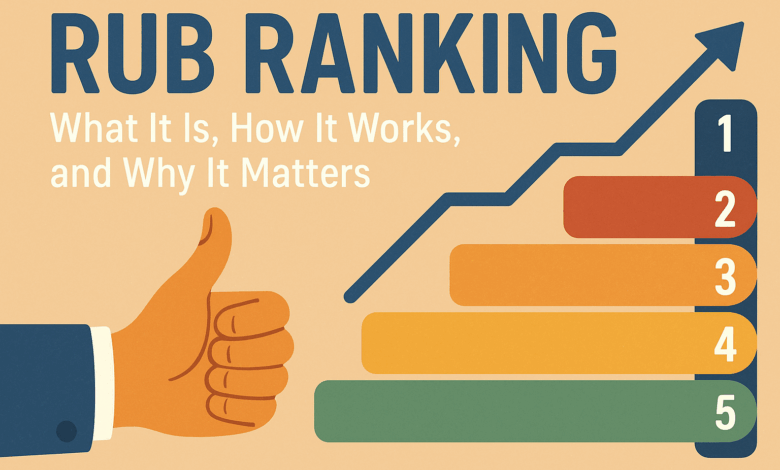Rub Ranking: What It Is, How It Works, and Why It Matters

The world of competitive activities, from culinary contests to massage therapy to even sports evaluations, the term rub ranking has started to gain attention. While it might not yet be a household term rub ranking is a concept that can be applied in various industries and scenarios, serving as a system for evaluating, rating, and comparing different products, services, or performances based on a defined set of criteria. We’ll explore what rub ranking is, how it works, and why it matters, especially in contexts where subjective judgments play a significant role.
What Is Rub Ranking?
Rub ranking is a method of comparative assessment where a set of items, individuals, or performances are evaluated and ranked based on certain qualities, features, or outcomes — typically through direct comparison or scoring systems. The term “rub” here can be traced to the idea of applying a “rubric” or a guideline for judging, or it may be associated with the actual process of physical interaction, as seen in fields like massage therapy or cooking (where spice rubs are ranked for flavor and aroma).
Rub ranking involves a structured or informal system that places entries in an ordered list, from best to worst, or according to other qualitative or quantitative scales.
Applications of Rub Ranking
The interesting thing about rub ranking is its versatility. It can be applied across different fields and industries. Let’s take a look at a few scenarios where rub ranking is commonly or could potentially be used:
-
Culinary Competitions
In barbecue cook-offs and grilling contests, for example, participants often prepare meats with unique spice rubs. Judges assess each rub based on taste, aroma, appearance, and how well it complements the meat. A rub ranking system might score each on a scale from 1 to 10 in several categories and then rank the overall performance. -
Massage Therapy Services
In wellness and spa directories, therapists might be ranked based on their skill in specific techniques, including various kinds of body rubs or massages. Clients can provide reviews, and an aggregate rub ranking helps new clients choose the best therapist for their needs. -
Product Reviews and Consumer Ratings
Products that involve the use of topical rubs — such as muscle relief balms or cosmetic skin treatments — are often reviewed by consumers. A rub ranking system could help categorize these based on effectiveness, scent, price, and user satisfaction. -
Sports Performance Evaluations
While not commonly called “rub ranking,” a similar concept exists in sports, where athletes are ranked based on their performance metrics in direct competition or practice drills, with rankings sometimes influenced by subjective factors such as style or technique. -
Online Content and Media
In entertainment and digital content, rub rankings can be applied to assess the popularity or quality of certain types of interactive or experiential media — such as virtual reality experiences, where tactile feedback or simulated “rubs” contribute to overall user immersion.
How Does Rub Ranking Work?
A rub ranking system typically involves the following components:
-
Criteria Definition: Establish clear and measurable categories or qualities to be evaluated.
-
Scoring or Comparative Judgment: Each entry is assessed either through a scoring system (numeric or descriptive) or by direct comparison.
-
Aggregation of Results: Scores or comparative judgments are aggregated, often through averaging or consensus-building.
-
Final Ranking: Items are ordered from highest to lowest based on their overall performance or score.
For instance, in a barbecue competition, judges might assign a score out of 10 for aroma, flavor balance, texture, and overall impression. The total score determines each participant’s rub ranking.
Why Rub Ranking Matters
The importance of rub ranking lies in its ability to bring order to subjective evaluation. In any setting where personal preference, sensory experience, or non-quantifiable performance plays a role, a well-defined ranking system can:
-
Ensure Fairness: By applying the same criteria across all entries, participants are judged on equal footing.
-
Guide Decision-Making: Rankings help consumers, clients, or audiences make informed choices based on aggregated experiences or expert judgments.
-
Encourage Improvement: Participants can learn from rankings, identifying strengths and weaknesses in their products, services, or performances.
-
Facilitate Healthy Competition: Rankings add a level of challenge and recognition, motivating individuals and organizations to aim for excellence.
Challenges in Rub Ranking
While useful, rub ranking systems also come with challenges:
-
Subjectivity: Especially in sensory-based evaluations, personal preferences can skew results.
-
Consistency: Ensuring that all evaluators interpret criteria similarly requires training and clear guidelines.
-
Transparency: Disclosing how rankings are determined is crucial for credibility.
Read More: The Chemical Composition and Significance of HCOOCH CH2 H2O
Conclusion
Rub ranking may not yet be a widely recognized term, but the practice of ranking based on comparative assessment is integral in many industries. Whether it’s determining the best spice blend for a steak, the most soothing massage therapist in a spa, or the highest-rated topical balm, ranking systems provide structure to subjective judgments, helping both providers and consumers navigate their options.
As industries continue to evolve and seek ways to refine evaluation and quality assurance processes, the concept of rub ranking — in name or in practice — is likely to find broader application and recognition.



